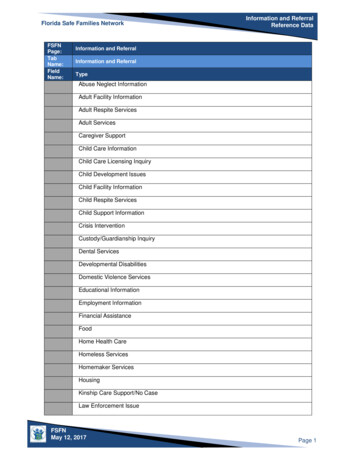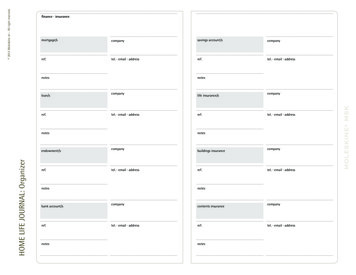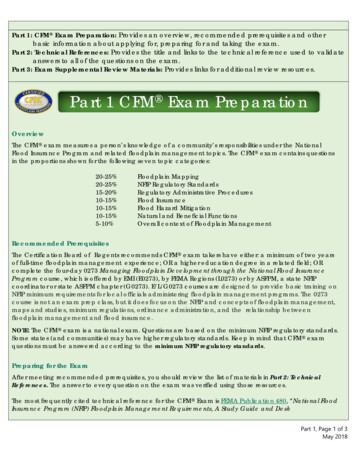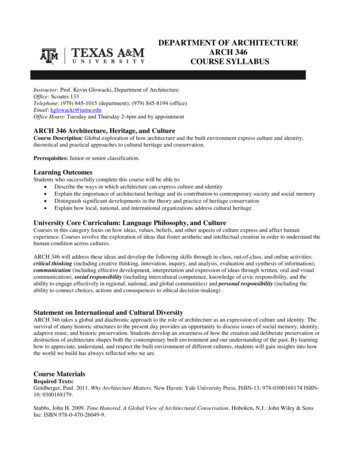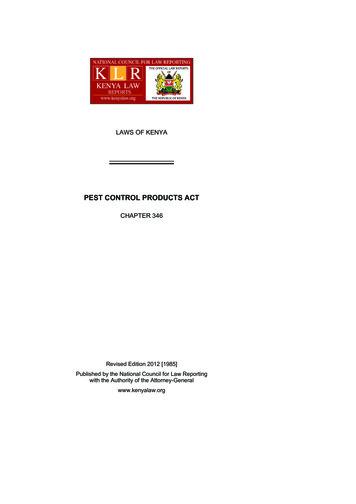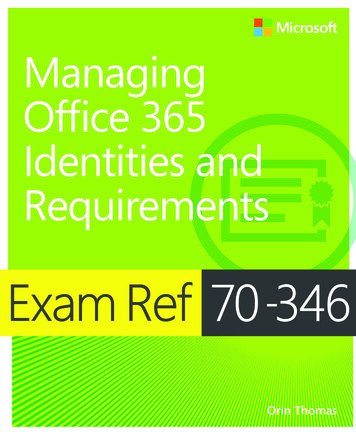
Transcription
Exam Ref 70-346ManagingOffice 365 Identitiesand RequirementsOrin Thomas
PUBLISHED BYMicrosoft PressA Division of Microsoft CorporationOne Microsoft WayRedmond, Washington 98052-6399Copyright 2015 by Orin ThomasNo part of the contents of this book may be reproduced or transmitted in any form or by any means withoutthe written permission of the publisher.Library of Congress Control Number: 2015936024ISBN: 978-1-5093-0066-2Printed and bound in the United States of America.First PrintingMicrosoft Press books are available through booksellers and distributors worldwide. If you need supportrelated to this book, email Microsoft Press Book Support at mspinput@microsoft.com. Please tell us what youthink of this book at http://aka.ms/tellpress.This book is provided ”as-is” and expresses the author’s views and opinions. The views, opinions and information expressed in this book, including URL and other Internet Web site references, may change without notice.Some examples depicted herein are provided for illustration only and are fictitious. No real association or connection is intended or should be inferred.Microsoft and the trademarks listed at http://www.microsoft.com on the ”Trademarks” Web page are trademarks of the Microsoft group of companies. All other marks are property of their respective owners.Acquisitions Editor: Karen SzallDevelopmental Editor: Karen SzallEditorial Production: Troy Mott, Ellie VolckhausenTechnical Reviewers: Mike Toot; Technical Review services provided byContent Master, a member of CM Group, Ltd.Copyeditor: Eryn Leavens and Christopher FriedmanIndexer: Julie GradyCover: Twist Creative Seattle
ContentsIntroductionxiMicrosoft certificationsxiFree ebooks from Microsoft PressxiiErrata, updates, & book supportxiiWe want to hear from youxiiStay in touchxiiiPreparing for the examxvChapter 1: Provision Office 3651Objective 1.1: Provision tenants. . . . . . . . . . . . . . . . . . . . . . . . . . . . . . . . . . . . . 1Setting up an Office 365 trial1Configure the tenant name6Tenant region6Administrator roles7Manage tenant subscriptions and licenses8Objective summary12Objective review13Objective 1.2: Add and configure custom domains. . . . . . . . . . . . . . . . . . . 14Specify domain name14Confirm ownership15Specify domain purpose22Move ownership of DNS to Office 36525Objective summary26Objective review26What do you think of this book? We want to hear from you!Microsoft is interested in hearing your feedback so we can continually improve ourbooks and learning resources for you. To participate in a brief online survey, please visit:www.microsoft.com/learning/booksurvey/iii
Objective 1.3: Plan a pilot. . . . . . . . . . . . . . . . . . . . . . . . . . . . . . . . . . . . . . . . . 27Designate pilot users28Identify workloads that don’t require migration28Run the Office 365 on-ramp readiness tool29Create a test plan or use case31Connect existing email accounts for pilot users32Service descriptions34Objective summary36Objective review36Answers. . . . . . . . . . . . . . . . . . . . . . . . . . . . . . . . . . . . . . . . . . . . . . . . . . . . . . . . . 38Objective 1.1: Thought experiment38Objective 1.1: Review38Objective 1.2: Thought experiment39Objective 1.2: Review39Objective 1.3: Thought experiment41Objective 1.3: Review41Chapter 2: Plan and implement networking and securityin Office 36543Objective 2.1: Configure DNS records for services. . . . . . . . . . . . . . . . . . . . 43Exchange DNS records44Skype for Business Online DNS records49SharePoint Online DNS records52Objective summary54Objective review54Objective 2.2: Enable client connectivity to Office 365. . . . . . . . . . . . . . . . 55ivContentsProxy server configuration56Outbound firewall ports56Recommend bandwidth57Internet connectivity for clients58Deploy desktop setup for previous versions of Office clients58Objective summary59Objective review59
Objective 2.3: Administer rights management . . . . . . . . . . . . . . . . . . . . . . . 60Activate Azure Rights Management60Office integration with Rights Management64Assign roles for Microsoft Azure Active Directory RM67Enable recovery of protected document68Objective summary69Objective review69Objective 2.4: Manage administrator roles in Office 365 . . . . . . . . . . . . . . 70Global administrator71Billing administrator71User management administrator72Service administrator72Password administrator73Delegated administrator73Manage role membership74Objective summary78Objective review79Answers. . . . . . . . . . . . . . . . . . . . . . . . . . . . . . . . . . . . . . . . . . . . . . . . . . . . . . . . . 80Objective 2.1: Thought experiment80Objective 2.1: Review80Objective 2.2: Thought experiment81Objective 2.2: Review81Objective 2.3: Thought experiment82Objective 2.3: Review82Objective 2.4: Thought experiment83Objective 2.4: Review83Chapter 3: Manage cloud identities85Objective 3.1: Configure password management. . . . . . . . . . . . . . . . . . . . . 85Working with cloud identities85Configuring password policies86Following password complexity policies87Resetting passwords88Objective summary94Objective review94Contentsv
Objective 3.2: Manage user and security groups. . . . . . . . . . . . . . . . . . . . . 95Using the bulk import process95Using soft delete98Enabling multi-factor authentication100Using Azure Active Directory Graph API104Objective summary107Objective review108Objective 3.3: Manage cloud identities with Windows PowerShell. . . . . 109Managing user passwords with Windows PowerShell109Hard deleting users111Performing bulk account operations112Using Azure Active Directory cmdlets114Objective summary122Objective review122Answers. . . . . . . . . . . . . . . . . . . . . . . . . . . . . . . . . . . . . . . . . . . . . . . . . . . . . . . . 124Objective 3.1: Thought experiment124Objective 3.1: Review124Objective 3.2: Thought experiment125Objective 3.2: Review125Objective 3.3: Thought experiment127Objective 3.3: Review127Chapter 4: Implement and manage identities by using DirSync129Objective 4.1: Prepare on-premises Active Directory for DirSync. . . . . . 129Using Active Directory synchronization toolsviContents130Cleaning up existing Active Directory objects135Using UPN suffixes and non-routable domains138Planning for filtering Active Directory143Supporting multiple forests143Objective summary144Objective review145
Objective 4.2: Set up DirSync. . . . . . . . . . . . . . . . . . . . . . . . . . . . . . . . . . . . . 146Meeting the DirSync installation requirements146Installing DirSync150Filtering160Identifying synchronized attributes163Syncing passwords165Objective summary166Objective review166Objective 4.3: Manage Active Directory users and groupswith DirSync in place. . . . . . . . . . . . . . . . . . . . . . . . . . . . . . . . . . . . . . . . . . 167Creating users and groups168Modifying users and groups169Deleting users and groups169Scheduling synchronization170Forcing synchronization170Objective summary173Objective review173Answers. . . . . . . . . . . . . . . . . . . . . . . . . . . . . . . . . . . . . . . . . . . . . . . . . . . . . . . . 175Objective 4.1: Thought experiment175Objective 4.1: Review175Objective 4.2: Thought experiment176Objective 4.2: Review176Objective 4.3: Thought experiment177Objective 4.3: Review178Chapter 5: Implement and manage federated identities(single sign-on)179Objective 5.1: Plan requirements for Active Directory Federation Services. 179Deploying AD FS topologies180Using certificates181Using namespaces191Meeting network requirements191Configuring multi-factor authentication192Accessing filtering using claims rules193Objective summary194Objective review194Contentsvii
Objective 5.2: Install and manage AD FS servers . . . . . . . . . . . . . . . . . . . . 195Creating AD FS service accounts196Configuring farm or stand-alone settings198Installing and configuring AD FS199Adding additional servers207Converting from standard to federated domain217Managing certificate life cycle218Objective summary220Objective review220Objective 5.3: Install and manage AD FS Proxy servers. . . . . . . . . . . . . . . 221Setting up perimeter network name resolution221Setting up certificates222Installing required Windows roles and features222Configuring AD FS Web Application Proxy225Setting custom proxy forms login page229Objective summary230Objective review231Answers. . . . . . . . . . . . . . . . . . . . . . . . . . . . . . . . . . . . . . . . . . . . . . . . . . . . . . . . 232Objective 5.1: Thought experiment232Objective 5.1: Review232Objective 5.2: Thought experiment233Objective 5.2: Review233Objective 5.3: Thought experiment234Objective 5.3: Review235Chapter 6: Monitor and troubleshoot Office 365availability and usage237Objective 6.1: Analyze reports. . . . . . . . . . . . . . . . . . . . . . . . . . . . . . . . . . . . 237viiiContentsOffice 365 reports238Mail reports238Usage reports239Skype for Business240SharePoint241OneDrive for Business242Auditing reports242
Protection reports243Rules reports244Data Loss Prevention reports244Objective summary245Objective review245Objective 6.2: Monitor service health. . . . . . . . . . . . . . . . . . . . . . . . . . . . . . 246Service Health Dashboard246Office 365 Management Pack251Windows PowerShell cmdlets264Objective summary265Objective review265Objective 6.3: Isolate service interruption. . . . . . . . . . . . . . . . . . . . . . . . . . 266Create a service request267Microsoft Remote Connectivity Analyzer272Microsoft Connectivity Analyzer277Transport Reliability IP Probe279Hybrid Free/Busy Troubleshooter280Objective summary284Objective review285Answers. . . . . . . . . . . . . . . . . . . . . . . . . . . . . . . . . . . . . . . . . . . . . . . . . . . . . . . . 286Objective 6.1: Thought experiment286Objective 6.1: Review286Objective 6.2: Thought experiment287Objective 6.2: Review287Objective 6.3: Thought experiment288Objective 6.3: Review288What do you think of this book? We want to hear from you!Microsoft is interested in hearing your feedback so we can continually improve ourbooks and learning resources for you. To participate in a brief online survey, please tsix
IntroductionThe 70-346 exam deals with advanced topics that require candidates to have an excellentworking knowledge of both Office 365 and Windows Server. Some of the exam comprisestopics that even experienced Office 365 and Windows Server administrators may rarely encounter, unless they are consultants who deploy new Office 365 tenancies on a regular basis.To be successful in taking this exam, candidates not only need to understand how to deployand manage Office 365, they need to understand how to integrate Office 365 with an onpremises Active Directory environment.Candidates for this exam are Information Technology (IT) Professionals who want tovalidate their advanced Office 365 and Windows Server management skills, configurationskills, and knowledge. To pass this exam, candidates require a strong understanding of howto provision Office 365, plan and implement networking and security in Office 365, managecloud identities, configure and manage identity synchronization between on-premises andcloud Active Directory instances, implement and manage federated identities, as well as havethe ability to monitor and troubleshoot Office 365 availability and usage. To pass, candidatesrequire a thorough theoretical understanding as well as meaningful practical experienceimplementing the technologies involved.This book covers every exam objective, but it does not cover every exam question. Onlythe Microsoft exam team has access to the exam questions themselves and Microsoft regularly adds new questions to the exam, making it impossible to cover specific questions. Youshould consider this book a supplement to your relevant real-world experience and otherstudy materials. If you encounter a topic in this book that you do not feel completely comfortable with, use the links you’ll find in text to find more information and take the time to research and study the topic. Great information is available on TechNet, through MVA courses,and in blogs and forums.Microsoft certificationsMicrosoft certifications distinguish you by proving your command of a broad set of skills andexperience with current Microsoft products and technologies. The exams and correspondingcertifications are developed to validate your mastery of critical competencies as you designand develop, or implement and support, solutions with Microsoft products and technologiesboth on-premises and in the cloud. Certification brings a variety of benefits to the individualand to employers and organizations.Introduction xi
MORE INFOALL MICROSOFT CERTIFICATIONSFor information about Microsoft certifications, including a full list of available certifications, go to ion/cert-default.aspx.Free ebooks from Microsoft PressFrom technical overviews to in-depth information on special topics, the free ebooks fromMicrosoft Press cover a wide range of topics. These ebooks are available in PDF, EPUB, andMobi for Kindle formats, ready for you to download at:http://aka.ms/mspressfreeCheck back often to see what is new!Errata, updates, & book supportWe’ve made every effort to ensure the accuracy of this book and its companion content. Youcan access updates to this book—in the form of a list of submitted errata and their If you discover an error that is not already listed, please submit it to us at the same page.If you need additional support, email Microsoft Press Book Support atmspinput@microsoft.com.Please note that product support for Microsoft software and hardware is not offeredthrough the previous addresses. For help with Microsoft software or hardware, go tohttp://support.microsoft.com.We want to hear from youAt Microsoft Press, your satisfaction is our top priority, and your feedback our most valuableasset. Please tell us what you think of this book at:http://aka.ms/tellpressThe survey is short, and we read every one of your comments and ideas. Thanks in advance for your input!xii Introduction
Stay in touchLet’s keep the conversation going! We’re on Twitter: http://twitter.com/MicrosoftPress.Introduction xiii
Preparing for the examMicrosoft certification exams are a great way to build your resume and let the world knowabout your level of expertise. Certification exams validate your on-the-job experience andproduct knowledge. Although there is no substitute for on-the-job experience, preparationthrough study and hands-on practice can help you prepare for the exam. We recommendthat you augment your exam preparation plan by using a combination of available studymaterials and courses. For example, you might use the Exam ref and another study guide foryour ”at home” preparation, and take a Microsoft Official Curriculum course for the classroomexperience. Choose the combination that you think works best for you.Note that this Exam Ref is based on publicly available information about the exam and theauthor’s experience. To safeguard the integrity of the exam, authors do not have access to thelive exam.Introduction xv
CHAPTER 1Provision Office 365Setting up an Office 365 tenancy is straightforwardas long as you have a good understanding of whatyou need to have ready before you provision thetenancy, and what steps you need to take immediatelyafter you provision the tenancy so that you can startseamlessly moving workloads into the cloud.I M P O R TA N THave you readpage xv?It contains valuableinformation regardingthe skills you need topass the exam.Objectives in this chapter: Objective 1.1: Provision tenants Objective 1.2: Add and configure custom domains Objective 1.3: Plan a pilotObjective 1.1: Provision tenantsThis objective deals with the basic process of setting up an Office 365 tenancy. To masterthis objective you’ll need to understand some of the prerequisites, such as what you’ll needto think about before signing up for an Office 365 subscription, what an Office 365 tenantname is, what the different administrator roles are, and what to manage regarding tenantsubscriptions and licensing.This objective covers the following topics: Set up an Office 365 trial Configure the tenant name Tenant region Administrator roles Manage tenant subscriptions and licensing1
Setting up an Office 365 trialTo set up an Office 365 trial, you need to have access to the following things: An email account that will be associated with the trial You should sign upfor a brand-new email account that you will use only with the trial. To ensure thatthe email account remains secure, you should also configure this account to usetwo-factor authentication. Outlook.com email accounts support two-factor authentication, including text-messages and time-based codes generated by apps that aredownloadable from each mobile operating system vendor’s app store. You shouldavoid associating a subscription, even a trial subscription, with a personal email account because trial subscriptions can eventually become ongoing corporate subscriptions.A mobile device that can receive SMS messagesyour identity.This device will be used to verifyOnce you have the prerequisite elements to set up an Office 365 enterprise trial, performthe following steps:1.Navigate to 365-enterprise-e3-business-software and click Free Trial.2.On the Welcome page, shown in Figure 1-1 (be aware that Office 365 screens are liableto change as the product evolves), provide the following information and click Next: First name Last name Input your last name. 2Chapter 1Region Note that you will be unable to change the region associated with thesubscription after signup. This should be the geographical region in which theorganization for which you are creating the subscription is based. For example,if you were in Hobart, in the state of Tasmania, Australia, you would chooseAustralia.Input your first name.Business email address Input the email address to be associated with the subscription. This should not be a personal account, but should be a secure accountcreated expressly for the purpose of being associated with the subscription. Thisaccount will be used if you need to recover the tenancy’s global administratoraccount password. Because the global administrator is able to take any action,you want to ensure that the account that the recovery password can be sent to issecure and is only accessible to authorized people.Business phone numbersubscription.Provision Office 365Input the phone number to be associated with the
FIGURE 1-1 Welcome page3.On the Create Your User ID page, shown in Figure 1-2, specify the following andclick Next: User name This will be the username of the global administrator account. For anorganization, the name for this account should not be a standard user name, butshould be appropriate for an account that will have the highest level of permissions.Company name This will be your organization’s onmicrosoft.com name. You’ll beable to configure Office 365 to use a more traditional domain name at a later pointin time.Password The password must be 8-16 characters, combine upper case and lowercase letters, numbers, and the following symbols: ! @ # % & * - [ ] \ : ‘ , . ? / " ( ) ;.Objective 1.1: Provision tenantsChapter 13
FIGURE 1-2 Create your user ID4.On the Prove You’re Not A Robot page, shown in Figure 1-3, provide a mobile phonenumber where you can receive a text message and click Text Me. The importanttakeaway from this page is that the secret to humanity defeating the eventual robotuprising is that robots are unable to read text messages.FIGURE 1-3 Prove you are not a robot4Chapter 1Provision Office 365
5.When you receive the text message, enter the verification code and then click Create My Account on the page shown in Figure 1-4.FIGURE 1-4 Enter the verification code6.On the Save This Info page, shown in Figure 1-5, review the information, which willinclude your Office 365 ID and the Office 365 sign-in page.FIGURE 1-5 Trial readyObjective 1.1: Provision tenantsChapter 15
Configure the tenant nameWhen you set up your Office 365 subscription, you specify a tenant name in the form ofname.onmicrosoft.com where name is the name you want to assign to your organization’stenancy. This name has to be unique and no two organizations can share the same tenantname. The tenant name cannot be changed after you configure your Office 365 subscription.You can assign a domain name that you own to the tenant so that you don’t have to usethe tenant name on a regular basis. For example, you might sign up to an Office 365 subscription with the tenant name contoso.onmicrosoft.com. Any accounts you create will use thecontoso.onmicrosoft.com email suffix for their Office 365 mailboxes. However, once you’veset up Office 365, you can assign a custom domain name and have the custom domain nameused as the primary email suffix. For example, assuming that you owned the domain namecontoso.com, you could configure your tenancy to use the custom domain name contoso.comwith the contoso.onmicrosoft.com tenancy. You’ll learn more about using custom domainslater in this chapter.While you can configure a custom domain name to be the default domain name and usethe custom domain name exclusively when performing Office 365 related tasks, you won’tbe able to remove the tenant name. The tenant name chosen at setup remains with thesubscription over the course of the subscription’s existence.MORE INFO ONMICROSOFT.COM DOMAINYou can learn more about initial onmicrosoft.com domains at 30188844-43f3-8db1-1b3a8e9cfd5a.Tenant regionTenant region determines which Office 365 services will be available to the subscription, thetaxes that will be applied as a part of the subscription charges, the billing currency for thesubscription, and the Microsoft datacenter that will host the resources allocated to the subscription. For example, selecting United States for a region will mean that your organization’sOffice 365 tenancy is allocated resources in a United States datacenter. Selecting New Zealandcurrently means that your organization’s Office 365 will be allocated resources in a datacenterin Australia as this is currently the closest Microsoft datacenter to New Zealand.Unlike other Office 365 settings, you cannot change the tenant region once you haveselected it. The only way to alter a tenant region is to cancel your existing subscription and tocreate a new subscription.MORE INFO ABOUT OFFICE 365 REGIONSYou can learn more about Office 365 regions at b97-9e67b8483e10.6Chapter 1Provision Office 365
Administrator rolesThere are five Office 365 management roles. The Office 365 roles are as follows: Global administrator Office 365 users assigned this role have access to all administrative features. Users assigned this role are the only users able to assign other admin roles.More than one Office 365 user account can be assigned the global admin role. The firsttenancy account created when you sign up for Office 365 is automatically assigned theglobal admin role. This role has the most rights of any available role.Billing administrator Office 365 users assigned this role are able to make purchases,manage subscriptions, manage support tickets, and monitor service health.Password administrator Office 365 users assigned the password admin role areable to reset the passwords of most Office 365 user accounts, except those assignedthe global admin, service admin, or billing roles. Users assigned the password adminrole can reset the passwords of other users assigned the password admin role.Service administrator Office 365 users assigned the service admin role are able tomanage service requests and monitor service health.User management administrator When assigned this role, users can resetpasswords and monitor service health. They can also manage user accounts, usergroups, and service requests. Users assigned this role are unable to delete accountsassigned the global admin role; create other admin roles; or reset passwords forusers assigned the billing, global, or service admin roles.To assign a user the global admin role, perform the following steps:1.In the Office 365 Admin Center, select the Active Users node under the Users node asshown in Figure 1-6.FIGURE 1-6 Active UsersObjective 1.1: Provision tenantsChapter 17
2.In the Active Users node, select the user that you want to assign global admin privilegesto and then click Edit.3.On the user properties page, click Settings.4.On the Settings page, select Yes under Assign Role and then select the GlobalAdministrator role as shown in Figure 1-7 and provide an email address wherepassword reset information can be sent. Ensure that this account is secure andprotected by two-factor authentication. Click Save to apply the changes.FIGURE 1-7 Global AdministratorMORE INFO ADMINISTRATOR ROLESYou can learn more about Office 365 Permissions at Manage tenant subscriptions and licensesYou can manage Office 365 tenant subscriptions from the Subscriptions node, which is underthe Billing node and is shown in Figure 1-8.8Chapter 1Provision Office 365
FIGURE 1-8 SubscriptionsWhen you are signed up to an Office 365 subscription that is not a trial subscription, you’llalso be able to view a node named Bills. You can use this node to review invoices by date.Organizations can pay for Office 365 by credit card or invoice. If you want to change thepayment method at a later point in time, you will need to call Office 365 support as alteringthe payment method cannot be performed through the Office 365 Admin Center.MORE INFO TENANT SUBSCRIPTIONS AND LICENSESYou can learn more about tenant subscriptions and licenses at b2-1c2f-477fa813-313e3ce0d896.Assigning licensesOffice 365 users require licenses to use Outlook, SharePoint Online, Skype for Business(formerly Lync Online), and other services. Users who have been assigned the global administrator or user management administrator roles can assign licenses to users when creatingnew Office 365 user accounts or can assign licenses to accounts that are created throughdirectory synchronization or federation.Objective 1.1: Provision tenantsChapter 19
When a license is assigned to a user, the following occurs: An Exchange Online mailbox is created for the user. Edit permissions for the default SharePoint Online team site are assigned to the user. The user will have access to Skype for Business features associated with the license. For Office 365 ProPlus, the user will be able to download and install Microsoft Officeon up to five computers running Windows or Mac OS X.You can view the number of valid licenses and the number of those licenses that have beenassigned on the Licenses node, which is underneath the Billing node in the Office 365 AdminCenter. This node is shown in Figure 1-9.FIGURE 1-9 LicensesYou can assign a license to a user by editing the properties of the user. To do this, selectthe user’s account in the Office 365 Admin Center and then click Edit. On the Licenses tab ofthe user’s properties, you can assign a license by selecting the check box next to each licensetype. You can also remove a license by clearing the check box. Figure 1-10 shows the Licensestab of the properties of an Office 365 user.10Chapter 1Provision Office 365
FIGURE 1-10 User licenseMORE INFO ASSIGNING LICENSESYou can learn more about assigning licenses at 596b5-4173-4627-b91536abac6786dc.Resolving license conflictsLicense conflicts occur when you have assigned more licenses than you have purchased.Methods that you can use to resolve this problem include: Purchasing more licenses This resolves the issue by ensuring that the number oflicenses being consumed matches the number of licenses that have been purchased.Removing licenses from existing users You can resolve license conflicts by removinglicenses from existing users so that the number of licenses being consumed matches thenumber of licenses that has been purchased.Deleting users In many cases, license conflicts occur because users who are nolonger associated with the organization are still consuming licenses. Deleting theseusers from Office 365 will release the licenses assigned to these users.Objective 1.1: Provision tenantsChapter 111
MORE INFO RESOLVING LICENSE CONFLICTSYou can learn more about resolving license conflicts at 7ec.EXAM TIPRemember that the account used to configure the Office 365 subscription will automatically be assigned the global administrator role.Thought experimentOffice 365 setup at FabrikamIn this thought experiment, apply what you’ve learned about this objective. Youcan find the answers to these questions in the “Answers” section at the end of thechapter.You have been asked to provide some advice to Fabrikam, a small manufacturing business that migrated to Office 365. Fabrikam needs your advice because theperson responsible for Fabrikam’s IT recently left the company. During the process,they handed over the credentials of all their Office 365 accounts to the CEO.The CEO also reports to you that there have been l
Microsoft certifications xi Free ebooks from Microsoft Press xii Errata, updates, & book support xii We want to hear from you xii Stay in touch xiii Preparing for the exam xv. Chapter 1: Provision Office 365 1. Objective 1.1: Provision tenants. 1 Setting up an Office 365 trial 1 Configure the tenant name 6
